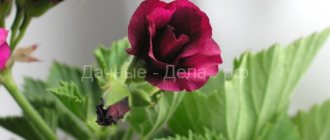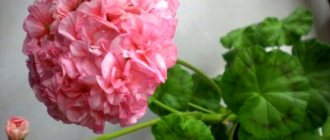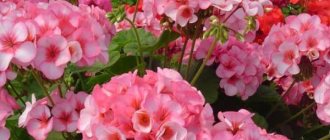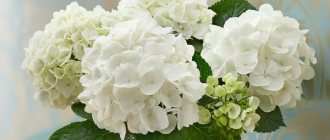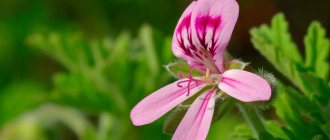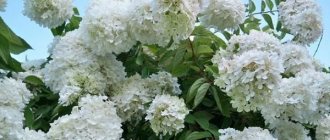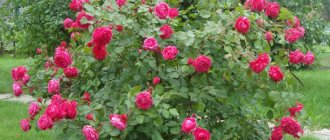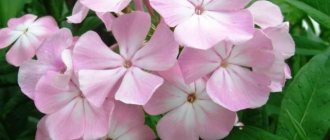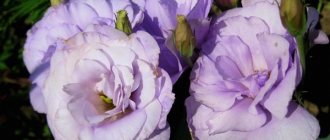On the southern tip of Africa there is a region with rich flora - this is the Cape region, the birthplace of rosebud geranium. It was from there that the colonialists brought it to the Old World. Pelargonium became widely known in the 18th century - first in England, then in Europe and Russia. The familiar name for home geranium is not directly related to pelargonium; they are united only by the large Geranium family. Unlike real geranium, pelargonium is an indoor plant used for street landscaping only in the summer.
Geranium is a wild and cultivated garden plant that can survive the winter at very low temperatures. Rosebud geranium (or rosebud geranium) was obtained by random mutation at the end of the 19th century in France. She inspired flower growers to breed such pelargoniums in different groups, resulting in varieties of zonal, ivy-leaved and dwarf rosebud pelargonium.
Its miniature buds consist of many petals and look like small roses.
Almost all geraniums have a specific smell due to the high content of essential oils. The smell is so pleasant that it was diluted with more expensive oils or passed off as rose oil.
Modern breeders have developed varieties with odors:
- roses;
- lemon;
- chocolate;
- pine needles;
- lavender.
Oils are widely used in medicine and cosmetologists. Pelargonium is able to purify the air from pathogenic bacteria and saturate the room with phytoncides. The plant is also endowed with mystical abilities. Popular beliefs speak of the flower’s ability to influence the owner’s fate for the better, help him organize family affairs and resolve financial problems.
What you need to know about geranium?
Basic requirements for long flowering geraniums:
- It can bloom all summer and autumn until winter if the flowerpot with it is placed on a window on the south side
- Loves direct sunlight
- In summer, geranium grows well and blooms at room temperature, in winter it has a dormant period, at this time we water it rarely and keep it in a cool place with a temperature of about 15 degrees Celsius
- In summer, water geraniums abundantly and often, as soon as the soil dries on top.
- We feed the flower once every 2 weeks with complex mineral fertilizer for flowering, starting from the end of March and ending in mid-November
- In autumn we prune the plant, leaving shoots with 6-7 leaves
- For abundant flowering in spring and summer, pinch out young shoots after 4-5 leaves have grown
- Geranium can reproduce by shoots and seeds
Attention: You can prepare geraniums for flowering when there is a lot of sunlight, at least 4-6 hours a day.
Care instructions
- Temperature. Pelargonium is a very heat-loving plant. Therefore, the optimal temperature should range between 25-27 degrees.
- The air should not be humidified too often. It is better if the humidity level is kept at 60%, no more.
- The soil should not be clogged.
- Watering. This plant does not tolerate large amounts of water in the substrate. Therefore, you should not moisturize it too often. You need to wait until the soil is completely dry before watering again. The optimal moisturizing regime is once every 10 days.
- In winter, the frequency of watering can be reduced to once every two weeks.
- Fertilizers are chosen with a high phosphorus content. It is better not to choose organic complexes; Pelargonium reacts poorly to them.
- You should choose a flowerpot that is not very large. In a wide pot, the plant will grow only in the root system area.
Flowering geranium
Geranium bordered or zoned
This variety of geranium is the most popular in the world. The plant got its name because in the middle of its leaves there is a peculiar border of brownish color. Flowers are usually two-colored and can be of the following forms:
- With 5 petals - simple
- With 6-8 petals - semi-double
- If a flower has 8 petals or more it is called double
If zonal geranium is not pinched, it can grow up to 1 m. A special feature of zonal geranium is its round inflorescences, usually protruding above the leaves.
Note. Only zonal geranium loves very bright light; other types of geranium can grow in partial shade.
Geranium zonal terry
Geranium in the form of roses
The double flowers of this geranium look like small roses. There are up to 20 of them in one inflorescence. The petals are one-color or two colors, their outer side is lighter.
Geranium in the form of roses
Geranium in the form of tulips
The flowers (1.5 cm in diameter) of this species resemble tulips that have not yet bloomed. They remain half-closed until the end of flowering. There are up to 40 flowers in one inflorescence. The flowers are pink or red, sometimes white, but rarely.
Geranium in the form of unopened tulips
Geranium unique
Geranium has strongly dissected leaves that have a faint odor. Can grow 1 m or more. Stems are woody. They bear small red flowers, less often pink or white, with dark veins or spots on the petals, like royal geraniums. The petals become lighter towards the middle.
Geranium unique
Geranium angel
This geranium grows in bushes up to 35 cm, no more. The flowers are small, usually two-colored, like pansies. The upper petals on the flower are larger than the lower ones. Geranium comes in a wide variety of shades.
Angel geranium is unpretentious and can grow in both sunny and shaded places. Where there is little light, a pot of geranium is hung and the flower is grown hanging down. And if there is a lot of sun, then the geranium bush grows upward and blooms profusely.
Attention. Geraniums of the “angel” and “royal” varieties are afraid of small white moths - whiteflies that infect them.
Angel Geranium
Royal Geranium
Geranium was called royal because of its beautiful large flowers (5-7 cm in diameter). The flowers are usually multicolored and come in the following colors:
- Darker or lighter in the middle
- Speckled
- Spotted or streaked
Geranium petals overlap each other like a fan.
The edges of the petals are:
- Simple
- Wavy
- Corrugated
The bushes are small in height - 30-60 cm. The leaves have serrations and are odorless. Royal geranium blooms less than other geraniums - 3-4 months. It is also more capricious - it grows only as an indoor flower, but dies in the open air.
How to plant correctly - rules and tips
Landing instructions
The described plant belongs to species that simply cannot tolerate excess moisture both in the soil and in the air. Therefore, the most important task of the gardener before planting is to provide a drainage layer .
So, how to plant Pelargonium correctly?
- Place a drainage layer 2-3 centimeters high on the bottom of the flowerpot.
- Next, the previously prepared soil is filled in.
- A small cutting is placed in the pot.
- To begin with, it is better to give preference to small containers. This way the plant will bloom faster and more abundantly.
- Cover the top with a transparent glass jar. This will ensure optimal moisture levels.
Reference! The soil is usually purchased ready-made. But you can cook it yourself. To do this, take equal parts of turf and leaf soil, as well as peat and coarse sand.
Choosing a location and lighting
Pelargonium is a very light-loving species. In the absence of light, this plant will stop producing essential oils and stop growing and flowering. Light should fall on the flower for at least 16 hours a day. For the location of Pink, it is better to choose the southern and eastern sides of the room. If necessary, experienced gardeners use phytolamps.
The soil must have good air and water permeability. Since stagnation of liquid in the substrate will cause rotting of the roots. The acidity of the soil should be neutral.
Video: Royal geranium of unusual colors
Geranium variegated
Geranium is valued for its beautiful leaves:
- White or brownish spots on a green leaf
- On a green leaf there is a border of a different color
- The leaf has veins of a different color
- Round or openwork
- Tricolor
Geranium of this variety blooms very rarely, and some varieties do not bloom at all.
Attention. To preserve the decorative appearance of the leaves of variegated geraniums, a lot of sun is required in summer, and in winter you will have to additionally illuminate the place with flowers.
Geranium variegated
Geranium cactus
Cactus geranium flowers have elongated, sometimes needle-shaped or curled petals. They can be one color or several. This type of geranium is rare.
Geranium cactus
Geranium ivy-leaved
The leaf shape of this geranium is similar to ivy leaves. Just like ivy, ivy-leaved geranium falls with its leaves and flowers downwards. Can grow up to 1 m in length. The leaves are smooth, glossy, monochromatic, sometimes variegated, looking like artificial flowers. Geranium flowers are up to 5 cm in diameter, with 5 or more petals.
Geranium ivy-leaved
Geranium dwarf
The height of geranium is 12-30 cm. It blooms profusely. There is no need to pinch the shoots; the geranium itself forms a neat bush.
Geranium dwarf
Interior use
Pelargonium is perfect for decorating loggias, balconies, terraces, front gardens, gazebos, office premises and window sills. Beautiful and abundant flowering allows you to fill even the most dull corner with bright colors.
Many gardeners plant flowers in flower beds, hanging pots or flowerpots.
Pelargonium can complement any floral or foliage arrangement. Flower growers plant flowers of the same color or create contrasting flower beds, and also use the most unusual options for combining the color palette.
White and dark-colored buds combine perfectly. Blue flowers look good next to purple and blue buds.
Varieties of fragrant geraniums
There are now up to 150 varieties of fragrant geranium. Geranium leaves have the following odors:
- Fruits (apples, peaches)
- Tropical fruits (lemon, pineapple, orange)
- Berries (strawberries, wild strawberries - Lady Scarborough variety)
- Flowers (roses, lavender, lily of the valley, wormwood)
- Spices (nutmeg, ginger, cinnamon)
- Candy (caramel)
- chocolate
- Coconut (Grossularioides variety)
- Mint
- Evergreens (pine, cedar, juniper)
- Almond
- Coca-Cola (Dorcas Brigham Lime variety)
- Menthol (Dark Lady variety)
- Balsam
- Men's perfume with a hint of tobacco (Brilliantine variety)
For fragrant geraniums, the main thing is the leaves. They are used as a natural flavor for tea, cosmetics and perfumes. Its flowers are usually inconspicuous, and some varieties bloom very rarely.
Video: Fragrant pelargonium: varieties, varieties, aromas
Most fragrant or most fragrant geranium
The round, slightly dissected leaves of this plant have an apple scent. It grows as a small spreading bush.
Geranium is the most fragrant
Geranium, scented or aromatic
The greyish-green, heavily lobed leaves of the plant have a rose scent along with a faint aroma of mint. The plant itself is branched, grows up to 30-60 cm in height, with bright pink flowers.
In addition to the main species, there are also subspecies that are classified as aromatic geranium:
- Geranium with leaves that smell strongly of mint and camphor
- Geranium with leaves, with a lighter border, the smell of eucalyptus, blooms with lilac-pink flowers
Geranium aromatica
Geranium capitata
Heart-shaped leaves, pubescent, strongly dissected, with a rich rose scent. The plant grows up to 60 cm in height. The flowers are small lilac-pink, burgundy at the base.
Geranium capitata
Geranium pink
This geranium can grow one and a half meters in height. It smells like roses with the addition of a subtle lemon scent. It grows like a shrub and blooms with pink flowers. Its leaves are strongly dissected into narrow strips.
In addition, rose geranium includes the following subspecies of geranium:
- With palmately dissected leaves, this geranium is also called "Crow's feet", with brighter colors than the main type of rose geranium.
- With even more rugged leaves than the main rose geranium and lilac-pink flowers
Geranium pink "Crow's feet"
Geranium rough
The leaves of rough geranium look very tough, but it destroys viruses better than all fragrant geraniums.
Geranium rough
Geranium curly
The leaves of curly geranium are small, round, dissected, with a golden edge, and have a citrus scent. The flowers are light pink, with burgundy lines on the petals at the base.
Attention. Curly geranium contains a lot of vitamin C, as well as substances such as apigenin and chrysin, which suppress the growth of cancerous tumors. Its leaves are brewed as tea and added to soups, desserts and baked goods.
Geranium curly
Geranium felt
The plant grows small, up to 30 cm tall, new shoots droop slightly. The leaves are medium-sized and large, round, half dissected into 3-5 lobes, pubescent, with a mint scent. The flowers are small, slightly pink with purple pistils, with purple spots on the petals the same color as the pistils.
Felt geranium
Geranium oakleaf
This geranium has large, dissected into 5-7 lobes, sticky leaves, with a balsamic scent and a light vanilla aroma. The plant grows up to 1 m. The inflorescence contains up to 10 pink flowers. Light petals have darker strokes.
Geranium oakleaf
Geranium fragrant
The plant has small, velvety, dull green leaves with a scent reminiscent of cinnamon. It blooms with white flowers, with crimson spots on the upper petals.
Geranium fragrant
Chocolate geranium
Chocolate geranium leaves are large, similar to maple leaves, with a large brown spot in the middle of the leaf. They smell like chocolate and mint. The plant can be planted in hanging pots and shaped so that it grows in a cascade.
Chocolate geranium
Description
Geranium or cranebird, from the point of view of scientific classification, is the name of the genus (Geranium) belonging to the Geranium family. This is a fairly numerous genus, it includes more than 400 species of various shapes, growing in many corners of the globe. Plants from the geranium genus are characterized by petiolate leaves with a very diverse shape of the leaf blade.
Geranium has very beautiful and quite large flowers, each of which consists of 5 sepals and 5 petals. The five-petalled corolla, which forms an almost perfect circle when opened, can be white, purple, blue or violet in color, depending on the species. Each peduncle can have from one to three flowers. The fruit, formed after rapid flowering, is shaped like the beak of a crane (hence the second name).
This family includes another genus - pelargonium (Pelargonium), whose habitat is South Africa. The genus includes about 250 species, and it is the ancestor of most known indoor varieties. Plants belonging to the genus Pelargonium have well-branched, erect or creeping stems. Petiolate leaves may have a simple, palmate or dissected leaf blade. Most types of pelargonium are light-loving and are distinguished by very beautiful and lush inflorescences, reminiscent of umbrellas in shape.
Geranium and pelargonium are very often confused and this is not surprising, because they are closely related plants belonging to the same family, but nevertheless, according to the scientific classification, these are two different genera, each of which is characterized by its own species.
What are the benefits of fragrant geranium?
Fragrant geranium contains about 120 useful components: organic acids, flavonoids, but the main ones are terpenoids. Essential oil of fragrant geranium is capable of:
- Increase the performance of the brain system
- Effective when applied to wounds, burns, frostbite, rinsing for stomatitis, dripping into the nose for sinusitis
- Stimulate the pancreas and liver
- It can help if you lubricate sore spots with acne and dermatitis.
- Together with warming ointments, improve the condition of arthritis and myositis
- If you drop a few drops of essential oil into an aroma lamp, it can soothe headaches and nerves due to nervous disorders, improve sleep, and lower blood pressure
- Rose geranium can improve the functioning of the endocrine system
- Useful for diabetics
Example. Essential oils of some varieties of fragrant geranium act on pathogenic microbes 6.5 times stronger than the strong antiseptic carbolic acid.
What diseases does fragrant geranium help with?
All varieties of fragrant geranium are medicinal. The leaves of fragrant geranium are the most medicinal; the roots, branches and flowers are less useful. People use them to prepare healing potions:
- Decoction. Helps with insomnia, nervous disorders and digestive problems.
For the decoction: 1 tbsp. l. Pour dried geranium leaves into 1 glass of boiling water, let it boil, leave for half an hour. We drink 1 tbsp. l. 3 r. per day, during meals.
- Infusion. An infusion of fragrant geranium heals wounds on the skin, in the mouth, and relieves inflammation of the eyes.
Infusion for rinsing: pick 10 geranium leaves, chop them finely, pour 1 glass of cold but boiled water, add 1 tsp. honey, leave for 8 hours.
To stop persistent diarrhea for a long time, prepare an infusion for oral administration: 2 tbsp. l. crushed geranium leaves, pour 0.5 liters of boiled cold water, leave for 8 hours. We drink small sips throughout the day.
Tincture. We wash wounds with tincture of fragrant geranium, gargle and gargle for colds, drink 0.5 tsp. 2 r. per day for insomnia.
We make the tincture like this: chop the fresh leaves, you need 3 tbsp. l., pour 0.5 cups of alcohol into the leaves, leave in the cupboard at room temperature for 7 days.
- Fresh leaves. Fragrant geranium leaves can reduce high blood pressure if crushed and smelled. For the same purpose, you can drip a crushed geranium leaf onto a handkerchief.
A geranium leaf will help cure hemorrhoids if you knead it and apply it to the sore spot.
Contraindications to taking fragrant geranium products
Fragrant geranium has many positive qualities, but there are also negative ones.
Who should not take folk medicine from fragrant geranium?
- People with high blood viscosity
- People with low blood pressure
- Children under 12 years old
- Pregnant women
- Women who are breastfeeding
- For people of old age
- People with chronic diseases of the stomach, liver, and kidneys during exacerbation
- For varicose veins
- People with bronchial asthma
- For people with individual intolerance to the smell of fragrant geranium
If you buy fragrant geranium and place it on the window in your room, it will kill all harmful microorganisms and you will get sick less. Beautifully flowering geraniums do not have medicinal properties, but they bloom very beautifully.
Features of reproduction
This flower reproduces vegetatively:
- cuttings;
- leaf plate;
- fragment of a leaf.
Leaf
The process of propagation by a leaf plate and a leaf fragment is similar to each other:
- The florist must choose a large, healthy leaf without defects. Then use a sharp knife to make cuts, as if dividing the sheet itself into triangular fragments.
- To prevent these cuts from rotting, they are sprinkled with ash or activated carbon.
- The leaf platinum is slightly deepened into the ground and covered with a jar until new leaves appear.
Cuttings
Young shoots are selected for planting , which after cutting are exposed to fresh air to dry. Select cuttings that have at least three leaves.
You can put the cuttings in water until new roots appear on them, or you can immediately plant them in the ground, but at the same time treat them with a growth stimulator.
Seeds
There is also propagation by seeds. It is not as fast as vegetative, but sometimes you have to resort to this method of reproduction.
- For planting, seeds are sown on the ground and lightly crushed with earth.
- The soil is sprayed with a spray bottle.
- Then the seed is covered with glass for a month.
- After this time, the first shoots will appear, which can already be picked.
To learn more about other varieties and types of pelargonium, read about rosebud, fragrant, dwarf, Pak, garden, zonal, Rococo, Stellar,.
Pelargonium of the Pink variety is considered a female flower, so it is given specifically to girls and women in recognition of its tenderness and romance.
Video: Geranium will bloom magnificently all year round
We recommend reading:
- What indoor flowers should be in every house or apartment?
- How to feed indoor flowers with hydrogen peroxide
- The most beautiful flowers in the world: names, photos
- Auspicious flowers for the bedroom
- What unpretentious flowers to plant on the balcony on the south and north sides
